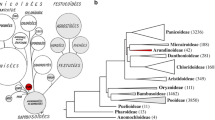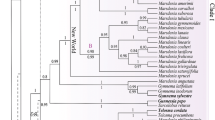Abstract
Malesherbiaceae are xerophytic plants of Chile, Peru, and Argentina. The 24 species of the only genus,Malesherbia, live in a variety of arid habitats in the Pacific coastal desert and adjacent Andes of Peru, Chile, and neighboring Argentina. Taxa with distributions in both Peru and Chile are rare; for this reason the family provides an excellent case study for the biogeography of this region of western South America.
Phylogenetic analysis of ITS sequence data using Turneraceae as an outgroup shows a correlation between the phylogeny and the distribution of Malesherbiaceae. The origin of the family is placed in the late Miocene to early Pliocene, when the region became permanently arid. The five major clades of the family likely diverged during the Pliocene. A single clade consisting of species native to Peru and the Atacama Desert indicates that the family was introduced to Peru once. Most modern species appear to have evolved in response to Pleistocene climatic fluctuations.
Resumen
Las Malesherbiaceae son plantas xerófitas de Chile, el Perú, y Argentina. Las 24 especies del genero único,Malesherbia, viven en una variedad de hábitats en el desierto costero del Pacífico y en la zona andina vecina en el Perú, Chile, y Argentina. Los taxones con distribuciones tanto en el Perú como en Chile son raros; por eso la familia es un buen ejemplo para el estudio de la biogeografía de esta región del oeste de América del Sur.
El análisis filogenético de datos de secuencias de ITS usando Turneraceae como un grupo extemo muestra una correlación entre la filogenia y la distribución de Malesherbiaceae. La familia se originó en el Mioceno tardío o Plioceno temprano, cuando la región se volvió permanentemente árida. Los cinco clados mayores de la familia probablemente divergieron en el Plioceno. Un solo clado que tiene especies nativas a Perú y el Desierto de Atacama indica que la familia llegó al Perú una vez. La mayoría de las especies modernas probablemente evolucionaron en respuesta a las fluctuaciones climáticas en el Pleistoceno.
Similar content being viewed by others
Literature Cited
Alpers, C. N. &G. H. Brimhall. 1988. Middle Miocene climatic change in the Atacama Desert, northern Chile: Evidence from supergene mineralization at La Escondida. Geol. Soc. Amer. Bull. 100: 1640–1656.
Arroyo, M. K. T., F. A. Squeo, J. J. Armesto &C. Villagrán. 1988. Effects of aridity on plant diversity in the northern Chilean Andes: Results of a natural experiment. Ann. Missouri Bot. Gard. 75: 55–78.
Börgel, R. 1973. The coastal desert of Chile. Pp. 111–114in D. H. K. Amiran & A. W. Wilson (eds.), Coastal deserts: Their natural and human environments. Univ. of Arizona Press, Tucson.
Brain, C. K. 1984. The Terminal Miocene Event: A critical environmental and evolutionary episode? Pp. 491–498in J. C. Vogel (ed.), Late Cainozoic palaeoclimates of the Southern Hemisphere. A. A. Balkema, Rotterdam.
Brüggen, J. 1950. Fundamentes de la geología de Chile. Inst. Geográfico Militar, Santiago, Chile.
Caviedes, C. 1973. A climatic profile of the north Chilean desert at latitude 20° south. Pp. 115–121in D. H. K. Amiran & A. W. Wilson (eds.), Coastal deserts: Their natural and human environments. Univ. of Arizona Press, Tucson.
Cofré, H. &P. A. Marquet. 1999. Conservation status, rarity, and geographic priorities for conservation of Chilean mammals: An assessment. Biol. Conservation 88: 53–68.
De Muizon, C. &T. J. de Vries. 1985. Geology and paleontology of the late Cenozoic marine deposits in the Sacaco area (Peru). Geol. Rundschau 74: 547–563.
DiCastri, F. &E. R. Hajek. 1976. Bioclimatología de Chile. Univ. Católica, Santiago, Chile.
Fay, M. F., S. M. Swensen, &M. W. Chase. 1997. Taxonomic affinities ofMedusagyne oppositifolia (Medusagynaceae). Kew Bull. 52: 111–120.
Flohn, H. 1984. Climate evolution in the Southern Hemisphere and the equatorial region during the Late Cenozoic. Pp. 5–20in J. C. Vogel (ed.), Late Cainozoic palaeoclimates of the Southern Hemisphere. A. A. Balkema, Rotterdam.
Gengler, K. M. 2000. Evolution and biogeography of Malesherbiaceae, an endemic family of arid western South America. Ph.D. diss., Ohio State Univ.
— &D. J. Crawford. 2000. Genetic diversities of four little-known species ofMalesherbia (Malesherbiaceae) endemic to the arid inter-Andean valleys of Peru. Brittonia 52: 303–310.
Goloboff, P. A. 1993. NONA, version 1.6. MS-DOS program. Published by the author, San Miguel de Tucumán, Argentina.
Gregory-Wodzicki, K. M. 2000. Uplift history of the Central and Northern Andes: A review. Geol. Soc. Amer. Bull. 112: 1091–1105.
Grosjean, M. 1994. Paleohydrology of the Laguna Lejía (north Chilean altiplano) and climatic implications for late-glacial times. Palaeogeogr. Palaeoclimatol. Palaeoecol. 109: 89–100.
Heusser, C. J. 1984. Late Quaternary climates of Chile. Pp. 59–83in J. C. Vogel (ed.), Late Cainozoic palaeoclimates of the Southern Hemisphere. A. A. Balkema, Rotterdam.
Kennett, J. P. 1980. Paleoceanographic and biogeographic evolution of the southern ocean during the Cenozoic, and Cenozoic microfossil datums. Palaeogeogr. Palaeoclimatol. Palaeoecol. 31: 123–152.
Kessler, A. 1984. The palaeohydrology of the Late Pleistocene Lake Tauca on the Bolivian Altiplano and recent climatic fluctuations. Pp. 115–122in J. C. Vogel (ed.), Late Cainozoic palaeoclimates of the Southern Hemisphere. A. A. Balkema, Rotterdam.
Klein, A. G., G. O. Seltzer &B. L. Isacks. 1999. Modern and last local glacial maximum snowlines in the Central Andes of Peru, Bolivia, and Northern Chile. Quatern. Sci. Rev. 18: 63–84.
Kumer, S., K. Tamura &M. Nei. 1993. MEGA: Molecular evolutionary genetics analysis, version 1.0. Pennsylvania State Univ., University Park.
Lauer, W. &P. Frankenberg. 1983. Late Glacial glaciation and the development of climate in southern South America. Pp. 103–114in J. C. Vogel (ed.), Late Cainozoic palaeoclimates of the Southern Hemisphere. A. A. Balkema, Rotterdam.
Lydolph, P. E. 1973. On the causes of aridity along a selected group of coasts. Pp. 67–72in D. H. K. Amiran & A. W. Wilson (eds.), Coastal deserts: Their natural and human environments. Univ. of Arizona Press, Tucson.
Markgraf, V., J. R. Dodson, A. P. Kershaw, M. S. McGlone &N. Nicholls. 1992. Evolution of late Pleistocene and Holocene climates in the circum-Pacific land areas. Clim. Dynamics 6: 193–211.
Martínez-Pardo, R. 1990. Major Neogene events of the southeastern Pacific: The Chilean and Peruvian record. Palaeogeogr. Palaeoclimatol. Palaeoecol. 77: 263–278.
Marty, R. C., R. B. Dunbar &M. R. Allen. 1987. Tertiary diatomite distribution in the Pisco Basin, Peru. Geol. Soc. Amer. Abstr. 19: 761.
Mercer, J. H. 1984. Late Cainozoic glacial variations in South America south of the equator. Pp. 45–58in J. C. Vogel (ed.), Late Cainozoic palaeoclimates of the Southern Hemisphere. A. A. Balkema, Rotterdam.
Messerli, B., M. Grosjean, G. Bonani, A. Bügi, M. A. Geyh, K. Graf, K. Ramseyer, H. Romero, U. Schottererer, H. Schreier &M. Vuille. 1993. Climate change and natural resource dynamics of the Atacama altiplano during the last 18000 yr: A preliminary synthesis. Mountain Res. Developm. 13: 117–127.
—,M. Grosjean &M. Vuille. 1997. Water availability, protected areas, and natural resources in the Andean desert altiplano. Mountain Res. Developm. 17: 229–238.
Moreno, P. I., C. Villagrán, P. A. Marquet &L. Marshall. 1994. Quaternary paleobiogeography of northern and central Chile. Revista Chilena Hist. Nat. 67: 487–502.
Mortimer, C. &N. Saric. 1975. Cenozoic studies in northernmost Chile. Geol. Rundschau 64: 395–420.
Paskoff, R. 1973. The Plio-Quaternary climatic changes along the semiarid seaboard of Chile. Pp. 147–151in D. H. K. Amiran & A. W. Wilson (eds.), Coastal deserts: Their natural and human environment. Univ. of Arizona Press, Tucson.
— 1977. Quaternary of Chile: The state of research. Quatern. Res. 8: 2–31.
Pérez, C. &C. Villagrán. 1994. Influencia del clima en el cambio florístico, vegetacional y edáfico de los bosques de “olivillo” (Aextoxicon punctatum R. et Pav.) de la Cordillera de la Costa de Chile: Implicancias biogeográficas. Revista Chilena Hist. Nat. 67: 77–90.
Peterson, U. 1958. Structure and uplift of the Andes of Peru, Bolivia, and Chile and adjacent Argentina. Bol. Soc. Geol. Perú 33: 57–129.
Rodbell, D. T. &G. O. Seltzer. 2000. Rapid ice margin fluctuation during the Younger Dryas in the tropical Andes. Quatern. Res. 54: 328–338.
Rundel, P. W., M. O. Dillon, B. Palma, H. A. Mooney, S. L. Gulman &J. R. Ehleringer. 1991. The phytogeography and ecology of the coastal Atacama and Peruvian deserts. Aliso 13: 1–49.
Seltzer, G. O. 1990. Recent glacial history and paleoclimate of the Peruvian-Bolivian Andes. Quatern. Sci. Rev. 9: 137–152.
— 1994. A lacustrine record of late Pleistocene climatic change in the subtropical Andes. Boreas 23: 105–111.
Simpson, B. B. 1975. Pleistocene changes in the flora of the high tropical Andes. Paleobiology 1: 273–294.
— 1979. Quaternary biogeography of the high montane regions of South America. Pp. 157–188in W. E. Duellman (ed.), The South American herpetofauna: Its origin, evolution, and dispersal. Mus. Nat. Hist., Univ. of Kansas, Lawrence.
Simpson V., B. 1971. Pleistocene changes in the fauna and flora of South America. Science 173: 771–780.
Spencer, K. C. &D. S. Seigler. 1985. Cyanogenic glycosides ofMalesherbia. Biochem. Syst. Ecol. 13: 23–24.
Taylor, D. W. 1991. Paleobiogeographic relationships of Andean angiosperms of Cretaceous to Pliocene age. Palaeogeogr. Palaeoclimatol. Palaeoecol. 88: 69–84.
Tosdal, R. M., A. H. Clark &E. Farrar. 1984. Cenozoic polyphase landscape and tectonic evolution of the Cordillera Occidental, southernmost Peru. Geol. Soc. Amer. Bull. 95: 1318–1332.
Trewartha, G. T. 1961. The Earth’s Problem Climates. Univ. of Wisconsin Press, Madison.
Veloso, A. &M. K. T. Arroyo. 1982. Caracteristícas del medio físico. Pp. 5–12in A. Veloso & E. Bustos-O. (eds.), La vegetation y los vertebrados ectotérmicos del transecto Arica-Lago Chungara. Oficina Regional de Ciencia y Tecnología de la UNESCO para América Latina y el Caribe, Montevideo, Uruguay.
sZinsmeister, W. J. 1978. Effect of formation of the west antarctic ice sheet on shallow-water marine faunas of Chile. Antarc. J. U.S. 13: 25–26.
Author information
Authors and Affiliations
Rights and permissions
About this article
Cite this article
Gengler-Nowak, K. Reconstruction of the biogeographical history of Malesherbiaceae. Bot. Rev 68, 171–188 (2002). https://doi.org/10.1663/0006-8101(2002)068[0171:ROTBHO]2.0.CO;2
Issue Date:
DOI: https://doi.org/10.1663/0006-8101(2002)068[0171:ROTBHO]2.0.CO;2




